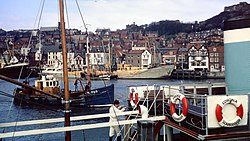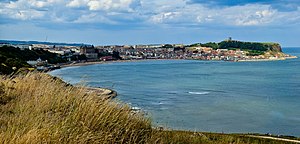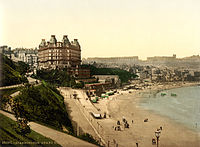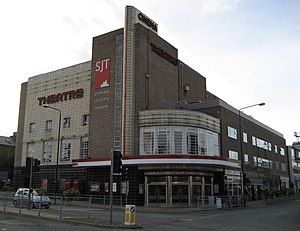Scarborough: Difference between revisions
Created page with '{{Infobox town |name=Scarborough |county=Yorkshire |riding=North |picture=Scarborough_collage.jpg |picture captionSights of Scarborough |os grid reference=TA043886 |latitude=54.2…' |
mNo edit summary |
||
| Line 3: | Line 3: | ||
|county=Yorkshire | |county=Yorkshire | ||
|riding=North | |riding=North | ||
|picture= | |picture=A busy harbour - geograph.org.uk - 1731971.jpg | ||
|picture | |picture caption=Scarborough Old Harbour | ||
|os grid reference=TA043886 | |os grid reference=TA043886 | ||
|latitude=54.285 | |latitude=54.285 | ||
Revision as of 17:21, 8 February 2012
| Scarborough | |
| Yorkshire North Riding | |
|---|---|
 Scarborough Old Harbour | |
| Location | |
| Location: | 54°17’6"N, 0°24’0"W |
| Data | |
| Population: | 50,135 (2001) |
| Postcode: | YO11-13 |
| Dialling code: | 01723 |
| Local Government | |
| Council: | Scarborough |
| Parliamentary constituency: |
Scarborough and Whitby |
Scarborough is a large town in the North Riding of Yorkshire, a seaside holiday resort standing on the North Sea coast, standing behind a bold, jutting headland into the North Sea.
The modern town stands up the hill, climbing steeply 230 feet above the harbour onto limestone cliffs. The older part of the town lies around the harbour and is protected by the rocky headland.
With a population of around 50,000 in the town's boundaries, Scarborough is the largest seaside resort in Yorkshire. The town is a fine mixture of residential districts, business, fishing and service industries, and a growing digital and creative economy: in 2008 Scarborough was named the most enterprising town in Britain[1] and won an award for the most creative and inspiring entrepreneurship initiative in Europe the next year. [2] and However the dominant theme of the town is as a tourist destination.
Name of the town
The town's name appears to come from Old Norse and in the sagas it appears twice, named Skarðaborg. The local belief is that the town was founded and named around 966 by Thorgils Skarði, a Viking named in Kormáks Saga.
The origin of the name is uncertain; it might be from Thirgils Skarði or the town's geography might suggest another Old Norse origin such as skara ("to jut out") or skarð ("notch") or skagi ("high headland"). The town is certainly known as Skarðaborg in the Norse period, being so named in Harold Sigurdson's saga,[3] and in Kormac's Saga.[4]
Layout of the town
The most striking feature of the town's geography is a high rocky headland pointing eastward into the North Sea. The headland supports the 11th century ruins of Scarborough Castle and separates the sea front into a North Bay and a South Bay. The South Bay was the site of the original early mediæval town and the harbour, which form the current Old Town district and which remains the main focus for tourism; here is a sandy beach, and cafés, amusements, arcades, theatres and entertainment facilities. The modern commercial town centre has migrated 440 yards northwest of the harbour area and 100 feet above it, and contains the transport hubs, main services, shopping and nightlife. The harbour has undergone major regeneration including the new Albert Strange Pontoons,[5] a more pedestrian-friendly promenade, street lighting and seating.
The North Bay has traditionally been the more peaceful end of the resort. Here is Peasholm Park which in June 2007 was restored to its Japanese-themed glory, complete with reconstructed pagoda. The park still features a mock maritime battle (based on the Battle of the River Plate) re-enacted on the boating lake with large model boats and fireworks throughout the summer holiday season.
The North Bay Railway is a miniature railway which runs from the park through Northstead Manor Gardens to the Sea Life Centre at Scalby Mills.The North Bay Railway has what is believed to be the oldest operational diesel hydraulic locomotive in the world; Neptune. Neptune was built in 1931 by Hudswell Clarke of Leeds in 1931 and is conveniently numbered 1931. Also in Nothstead Manor Gardens are other attractions; a water chute and a boating lake. The Open Air Theatre, opened in 1932 was closed in 1986.
The North Bay is linked to the South Bay by the Marine Drive, an extensive Victorian promenade, built around the base of the headland. Overlooking both bays is Scarborough Castle, which was bombarded by the German warships Derfflinger and Von der Tann in the First World War. Both bays have popular sandy beaches and numerous rock-pools at low tide.
The South Cliff Promenade above the Spa and South Cliff Gardens command excellent views of the South Bay and Old Town; views seen in many a postcard. Its splendid Regency and Victorian terraces are still intact and the mix of quality hotels and desirable apartments form a backdrop to the South Bay.
The South Bay has the largest illuminated "Star Disk" anywhere in the United Kingdom. It is 85 feet across and is fitted with subterranean lights representing the 42 brightest stars and major constellations that can be seen from Scarborough in the northern skies.
 |
-
The South Bay at Scarborough
-
Spa Bridge (footbridge), Scarborough
-
The "Belle" at Scarborough Lighthouse
-
First World War recruitment poster depicting the German bombardment in 1915
To the south-west of the town, beside the York to Scarborough railway line, is an ornamental lake known as Scarborough Mere. During the 20th century, the Mere was a popular park, with rowing boats, canoes and a miniature pirate ship – the Hispaniola – on which passengers were taken to "Treasure Island" to dig for doubloons. Since the late 1990s the emphasis has been on nature, and "Treasure Island" has been paved over to form a new pier area. The lake is now part of the Oliver's Mount Country Park and the Hispaniola now sails out of the South Bay.
History
Early history

In the 4th century there had been a Roman signal station on Scarborough's headland, and there is evidence of much earlier Stone Age and Bronze Age settlements.
The local legend has it that the town was founded around 966 AD as Skarðaborg by Thorgils Skarði, a Viking raider known from Kormáks Saga, in which Skarðaborg is named. In 1066 the town was burnt by Harold Hardrada, King of Norway, during his invasion of England. His saga, Haralds Saga Sigurðarsonar reports that King Harold came to Scarborough and fought with the townsmen. He went up onto the hill which was above the town and built a huge pyre. Then with pitchforks they furled flaming faggots down onto the town and utterly destroyed it.[3] The local legend is that the folk of Scarborough had fallen out with Tostig, the deposed Earl of Northumbria who was lord of the neighbouring village (and brother of King Harold II), and the destruction of their town was part of Tostig's revenge.
Little remained of Scarborough to be recorded in the Domesday Book survey of 1085. Scarborough recovered under King Henry II, who built a stone castle on the headland, and granted the town charters in 1155 and 1163, permitting a market on the sands, and establishing rule by burgesses.
Edward II granted Scarborough Castle to his favourite, Piers Gaveston, the cause of much grief in the land. The castle was beseiged by forces led by Percy, Warenne, Clifford and Pembroke, and Gaveston was captured and transported to Oxford and on Warwick Castle for execution.
Scarborough Fair
A royal charter of 1253 created Scarborough Fair, held a six-week trading festival attracting merchants from all over Europe. In the Middle Ages the fair ran from Assumption Day, 15 August, until Michaelmas Day, 29 September, and fair continued to be held for 500 years, from the 13th century to the 18th century. It is commemorated in the song Scarborough Fair:
Are you going to Scarborough Fair?
—parsley, sage, rosemary and thyme.
Remember me to one who lives there,
For once she was a true love of mine.
Modern Period
During the English Civil War of the 1640s, Scarborough and its castle changed hands seven times between Royalists and Parliamentarians, enduring two lengthy and violent sieges. When the civil war has ended, much of the town lay in ruins.
In 1626, Elizabeth Farrow discovered a stream of acidic water running from one of the cliffs to the south of the town.[6] This gave birth to Scarborough Spa, and Dr Wittie's book about the spa waters published in 1660 attracted a flood of visitors to the town. Scarborough Spa became Britain's first seaside resort, though the first rolling bathing machines were not noted on the sands until 1735.
The coming of the |Scarborough to York railway in 1845 increased the tide of visitors. To this day Scarborough railway station holds the record for the longest seat in any railway station in the world.[7]
This influx of visitors convinced a young architect (John Gibson) with an eye to the future to open Scarborough's first purpose-built hotel, The Crown. In 1841 a railway link between York and Scarborough was being talked of and he decided that the area above the popular Spa building could be developed. He designed and laid the foundations of a 'hotel' (a recently popularised word from French by way of America). Gibson then passed the construction of this hotel to the newly-formed South Cliff Building Company. On Tuesday, 10 June 1845 Scarborough's first hotel was opened—a marketing coup at the time, as the Grand Hotel, soon to be Europe's largest, was not yet finished. When John Fairgray Sharpin came to visit Scarborough in 1845, he was charmed at first sight.

When the Grand Hotel was completed in 1867 it was one of the largest hotels in the world and one of the first giant purpose-built hotels in Europe. Four towers represent the seasons, 12 floors represent the months, 52 chimneys represent the weeks and originally 365 bedrooms represented the days of the year. A blue plaque outside marks where the novelist Anne Brontë died in 1849.
During First World War, the town was bombarded by German warships of the High Seas Fleet, an act which shocked British opinion and security.
In June 1993, Scarborough made headlines around the world when a landslip caused part of the Holbeck Hall Hotel, along with its gardens, to fall into the sea. Although the slip was shored up with rocks and the land has long since grassed over, evidence of the cliff's collapse remains clearly visible from The Esplanade, near Shuttleworth Gardens.
Scarborough today
Scarborough is one of Yorkshire's 'renaissance towns', having been granted government support for securing a vibrant future. As a result there are many building projects to renovate classic Victorian buildings and quality contemporary architecture.
The town has a fine parish church, St Martin-on-the-Hill. It was built in 1862-63 as the parish church of South Cliff and contains works by Dante Gabriel Rosetti, William Morris, Edward Burne Jones and Ford Maddox Brown. The church remains very active and thriving.
Natives of Whitby up the coast call people from Scarborough, Algerinos. The origin of this nickname comes from the sinking of a boat called The Algerino not far from Scarborough. The lifeboat crews of several neighbouring towns including Whitby and Robin Hood's Bay responded, while the Scarborough lifeboat did not. Thus as a constant reminder the folk of Scarborough are referred to as 'Algerinos' and Scarborough 'Algerinoland'.
Economy
Scarborough's fishing industry is still active, though only a shadow of its former self. The working harbour is home to a fish market including a shop and wooden stalls where fishermen sell fresh, locally-caught seafood to the public.
The tourism trade continues to be a major part of the local economy despite the current affordability of foreign holidays. While weekend and mid-week-break trade are tending to replace the traditional week-long family holiday, the beaches and attractions are always very busy throughout summer – a marked contrast to the quieter winter months when Scarborough is often seen as a peaceful bolt-hole from cities such as Leeds and Bradford. Confidence in the hospitality industry is high, evidenced by major refits in recent years, often targeted at a higher-spending clientele. Significant amongst these is the Grand Hotel, Scarborough's biggest hotel, which overlooks the South Bay, and the Palm Court Hotel.
Shopping
Scarborough's busy town centre has many major shopping chains alongside boutique, independent shops. On the main pedestrianised shopping street and the Brunswick shopping centre are chain stores and cafés. Boutique stores can be found on Bar Street and St Thomas Street. The town also has an indoor market with a large range of antique shops and independent traders in its vaults, and a smaller market on the South Bay.
Industries
The printing industry is well represented. Pindar is a Scarborough-born company with an international profile and has its main base on the business park. Plaxtons has been building coaches and buses since 1907 and is still one of Scarborough's largest employers.
Creative industries
The Creative Industries have been cited as playing a vital role in the regeneration of Scarborough – a report in 2005 estimated that they comprised 19% of the town's economy. The creative industries were also a major focus of Scarborough's winning entry in the 2008 Enterprising Britain competition with a representative from Woodend Creative Workspace and scarborough-based Electric Angel Design representing the town in the Yorkshire and Humber regional heats. In the finals in London on 16 October 2008 Scarborough won the title of Britain's Most Enterprising Town[1] and subsequently went on to win the European Enterprise Awards on 13 May 2009.[2]
In 2010 the town was the winner of the 'Great Town Award', as nominated by the Academy of Urbanism, beating Chester and Cambridge respectively. In 2006 and 2010, Scarborough won a Gold Award at the Britain in Bloom ceremony in the 'Large Coastal' category.
Culture

Scarborough has a wide cultural aspect, spread across the town and seafront. It draws people not only from around the country, but from across the world.
Drama
Dramatist Alan Ayckbourn is based in Scarborough where he has lived for a number of years. He has produced seventy five plays in Scarborough and is the artistic director of the famous Stephen Joseph Theatre, where almost all his plays receive their first performance.
The town also plays host to the annual National Student Drama Festival, which takes place at the Stephen Joseph Theatre, the Spa Centre and other venues around the town. The Futurist Theatre is a theatre and cinema on the seafront, of the South Bay.
The Open Air Theatre, seating 6,500, has been recently restored, and was officially opened by The Queen on 20 May 2010.[8]
Cinema
Scarborough currently has two cinemas one at the Futurist Theatre on Sandside and the other is Hollywood Plaza on North Marine Road. Both of these cinemas have been operating a number of years.
Music
The Grade II listed Scarborough Spa complex is home to the Scarborough Spa Orchestra, the last remaining seaside orchestra in the UK. The orchestra gives ten concerts every week during the summer months, playing music from an extensive repertoire of classical and light music with no programme repeats. It became famous during the 1950s and 1960s when concerts from the Palm Court in Scarborough were frequently featured on BBC radio, conducted by Max Jaffa. Former conductors include the composer of the waltz 'Nights of Gladness', Charles Ancliffe.
The town is home to a significant jazz festival each September and in the summer boasts 'Beached Festival' – an eclectic rock and pop festival which takes place on the South Bay beach and features at least 50% local talent alongside internationally-known artists. In summer 2005, Scarborough played host to the Sonic Arts Network Expo featuring cutting-edge performances and installations.
'Acoustic Gathering', a free one-day music festival, has been held annually in Peasholm Park since September 2005. This features over 20 bands and singer/songwriters from all parts of the United Kingdom including a number of local groups and musicians, all performing from the bandstand in the centre of the lake.[9]
Seafest
Seafest is an annual festival which takes place at West Pier and around the harbour area in July. It celebrates the regions connection to fishing and hosts the region's biggest gathering of folk singers, shantymen and musicians. So far the programme has included the cream of the folk song, maritime and shanty world in the United Kingdom. It has also drawn artists from other maritime nations including Senegal, Sicily, Canada, Luxembourg, Germany, Holland, Brittany and America.
The festival is based around Scarboroughs West Pier and North Wharf where you will find a maritime themed exhibition, The Cropton Brewery Real Ale Bar and Children's Entertainment and our festival main stage. In addition there is the well known 'Sea Fish Cookery' marquee where visiting chefs demonstrate the art of seafood preparation.
Digital Scarborough
In recent years, arts, business and education have collaborated annually to produce Digital Scarborough – a celebration of the town's digital activities including a wide range of events, from business networking to film showings and gigs with DJs and VJs.
Film and television
Films made in or around Scarborough include:
- Little Voice (1998)
- Possession (2002)
- A Chorus of Disapproval (1988)
Scenes in Scarborough are found in
- Miranda (2002 film)
- Dancing Queen
- Beltenbros
- The Brides in the Bath
- The Damned United
Television drama series filmed in the Scarborough area include Heartbeat and its spin-off series The Royal.
Sport
- Rowing: Scarborough Amateur Rowing Club, founded in May 1869; the oldest surviving rowing club on the north-east coast
- Sailing: Scarborough Yacht Club, which holds each year a 210 nautical mile race, from the town, to IJmuiden in the Netherlands.
- Cricket: Scarborough Cricket Club
- Football: Scarborough Athletic, though its home ground is in Bridlington
- Golf: North Cliff Golf Course and and South Cliff Golf Course. Ganton Golf Club is 8 miles to the west of Scarborough.
Outside links
References
- ↑ 1.0 1.1 Crothers, Laura (17 October 2008). "Scarborough triumphs as 'most enterprising town in UK'". Scarborough Evening News. http://www.scarborougheveningnews.co.uk/news/Scarborough-triumphs-as-39most-enterprising.4604107.jp. Retrieved 2009-08-26.
- ↑ 2.0 2.1 Asquith, Ed (14 May 2009). "Scarborough are champions of Europe". Scarborough Evening News. http://www.scarborougheveningnews.co.uk/news/Scarborough-are-champions-of-Europe.5265861.jp. Retrieved 2009-05-15.
- ↑ 3.0 3.1 Síðan lagði Haraldur konungur til Skarðaborgar og barðist þar við borgarmenn. Hann gekk upp á bergið það sem þar verður og lét þar gera bál mikið og leggja í eld. – Haralds Saga Sigurðarsonar, Chap 83
- ↑ Síðan sneru þeir aftur bræður og til Noregs en Þorvaldur tinteinn fór til Íslands. En þeir bræður herjuðu um Írland, Bretland, England, Skotland og þóttu hinir ágætustu menn. Þeir settu fyrst virki það er heitir Skarðaborg. Þeir runnu upp á Skotland og unnu mörg stórvirki og höfðu mikið lið. Í þeim her var engi slíkur sem Kormákur um afl og áræði. Kormáks Saga, Chap 27
- ↑ Wynne, Dick (23 July 2008). "The Albert Strange Moorings at Scarborough". The Albert Strange Association. http://www.albertstrange.org/?p=209. Retrieved 2008-09-12.
- ↑ J. Christopher Holloway; Neil Taylor (2006). The business of tourism. Pearson Education. p. 29. ISBN 0273701614.
- ↑ Staff. "Scarborough Tourist Information". www.hello-yorkshire.co.uk. http://www.hello-yorkshire.co.uk/scarborough/tourist-information. Retrieved 2009-08-26.
- ↑ "Queen opens Scarborough open air theatre". BBC News Online. BBC. 20 May 2010. http://news.bbc.co.uk/1/hi/england/north_yorkshire/8694256.stm. Retrieved 21 May 2010.
- ↑ Jackson, Alex (16 September 2006). "Blast Arts 2006 - A musical treat!". BBC North Yorkshire. http://www.bbc.co.uk/northyorkshire/content/articles/2006/09/14/a_musical_treat_feature.shtml. Retrieved 2009-08-26.
- The borough of Scarborough, in William Page (ed.) (1923), A History of the County of York North Riding: Volume 2, Victoria County History series, pp. 538-560



